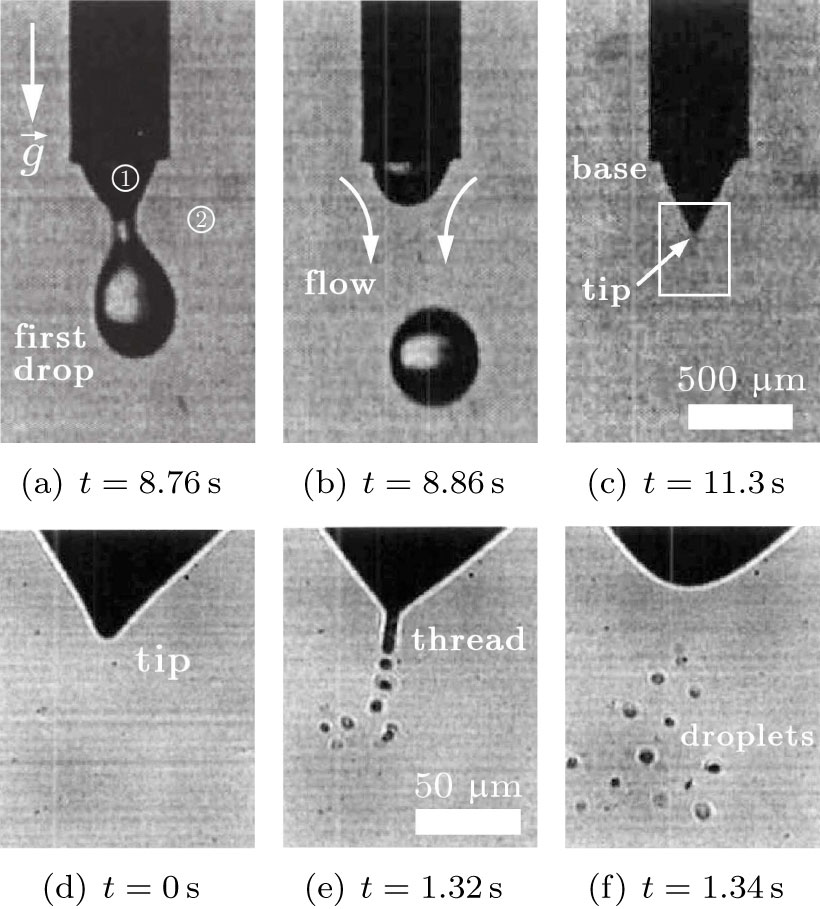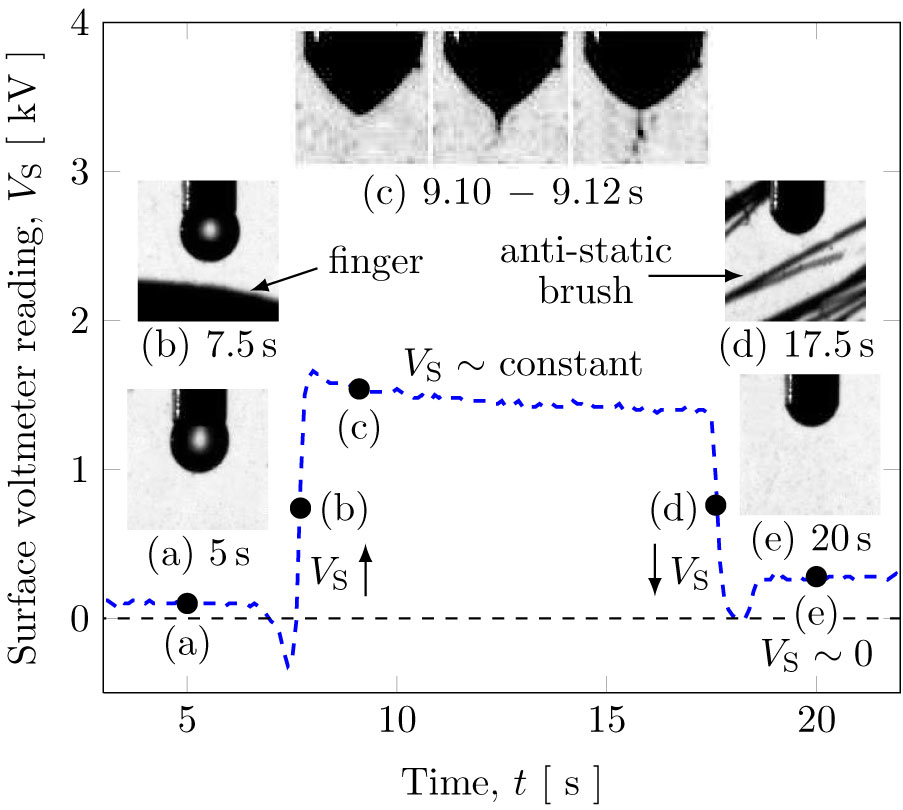58th Annual Report on Research 2013 Under Sponsorship of the ACS Petroleum Research Fund
Reports: ND551307-ND5: Theoretical and Experimental Study of Dynamic Boundary Conditions at Surfactant-Laden Interfaces
Rouslan Krechetnikov, University of California (Santa Barbara)
Contributions. The formation of microdroplets [1] is of vital importance in fields such as chemistry and biology, which nowadays take advantage of miniaturization and compartmentalization [2], with a variety of applications such as controlled drug delivery, encapsulation of DNA and protein, as well as clinical and environmental field testing, to name a few. It is not only their small volumes, but also monodipsersity and high frequency of production that make microdroplets indispensable for emerging technologies that require reduced reagent consumption, rapid mixing, continuous processing, and high throughput. At present, microfluidic methods of droplet formation help to overcome the inherent drawback – the polydispersity in droplet size – of bulk methods to produce microdroplets such as industrial homogenizers.
In this context, the peculiar observation of the spontaneous motion of a water-alkali pendant drop at the tip of a capillary in the oil-acid environment reported by Fernandez and Homsy [3] (FH) was a promising finding, cf. Figure 1, named chemical reaction-driven tip-streaming (CRDTS). By their account the drop oscillated in a self-sustained fashion, emitting small droplets without any externally imposed flow field.
In the physical problem at hand, a chemical reaction at the interface between two phases – less viscous phase 1 in the pendant drop (water + alkali, sodium hydroxide NaOH) and surrounding more viscous phase 2 (oil + linoleic acid) – produces a nearly insoluble surfactant, cf. Figure 1. As a possible explanation of the observed phenomena, it was suggested by FH and Krechetnikov and Homsy [4] (KH) that the surfactant ends up being distributed non-uniformly along the interface in a self-sustained fashion, which drives Marangoni flow in both phases and sweeps surfactant towards the tip of the conical drop. The resulting low interfacial tension in the tip area allows the interface to elongate and to create a thin thread, cf. Figure 1(e), through which the phase 1 is ejected into phase 2.
With the support of ACS PRF, we performed a series of experiments [5], which uncovered the true nature of chemical reaction-driven tip-streaming as first reported by Fernandez and Homsy [3] and found that, although peculiar, it was not a self-sustaining droplet formation phenomenon as previously thought. It is clear now, after a systematic experimental investigation involving careful observations and measurements, that the phenomenon is really initiated and sustained by electric forces resulting from contact electrification of the experimental apparatus, cf. Figure 2. Coincidentally, the original experiments of Fernandez and Homsy employed materials (plastics and rubbers) that can easily acquire charge with minimal contact and the oil-water-surfactant chemistry is such that the water phase is highly conductive and the interfacial tension can achieve extremely low values. Perhaps if the dynamic interfacial tension measurements of Fernandez and Homsy [6, 3], which led to their observations, had been accomplished using an inverted oil-acid droplet immersed in the water-alkali solution the CRDTS phenomenon would have never been discovered. In retrospect, without knowing that static charge was present on the experimental apparatus coupled with the presence of surfactant and observed motion, it was only logical that Marangoni effects are solely responsible for the phenomenon – the present study does point out their major influence which differentiates CRDTS from standard ES. All the studies of CRDTS to date [3, 4, 8], including the present one, lead to the key intriguing question – while in the present experiments Marangoni stresses alone cannot maintain tip-streaming, the theory by one of the authors [8] proves the possibility of the existence of tips-streaming driven purely by Marangoni effects, which is yet to be discovered experimentally.
Impact. At the educational level, the project allowed to train a graduate student and several undergraduate students (not directly supported by ACS PRF) in interdisciplinary research activities, as well as to enhance the education of other graduate and undergraduate students through results that are incorporated into courses taught by the PI. Active involvement of underrepresented groups in the research program at all levels was promoted through the NSF-supported California Alliance for Minority Participation at UCSB, through which the PI has already recruited a few students.
In conclusion, the proposed research provided fundamental proof-of-concept results, which will
serve as a basis for an NSF proposal and place my group in a strategic position to continue
research in a new to me field of physical chemistry. [1] E. R. Lee. Microdroplet generation. CRC Press, 2002. [2] G. M. Whitesides. The origins and the future of microfluidics. Nature, 442:368 – 373, 2006. [3] J. M. Fernandez and G. M. Homsy. Chemical reaction-driven tip-streaming phenomena in a pendant drop. Phys. Fluids, 16:2548–2555, 2004. [4] R. Krechetnikov and G. M. Homsy. On physical mechanisms in chemical reaction-driven tip-streaming. Phys. Fluids, 16:2556–2566, 2004. [5] H. C. Mayer and R. Krechetnikov. The nature of chemical reaction-driven tip-streaming. J. Appl. Phys., 113, 2013. 174907. [6] J. M. Fernandez and G. M. Homsy. Viscous fingering with chemical reaction: effect of in-situ production of surfactants. J. Fluid Mech., 480:267–281, 2003. [7] Y. Touhami, V. Hornof, and G. H. Neale. Dynamic interfacial tension behavior of acidified oil/surfactant-enhanced alkaline systems - 1. Experimental studies. Colloids and Surfaces A, 132:61–74, 1998. [8] R. Krechetnikov. Structure of Marangoni-driven singularities. Phys. Fluids, 24:022111, 2012.
Copyright © 2014 American Chemical Society













